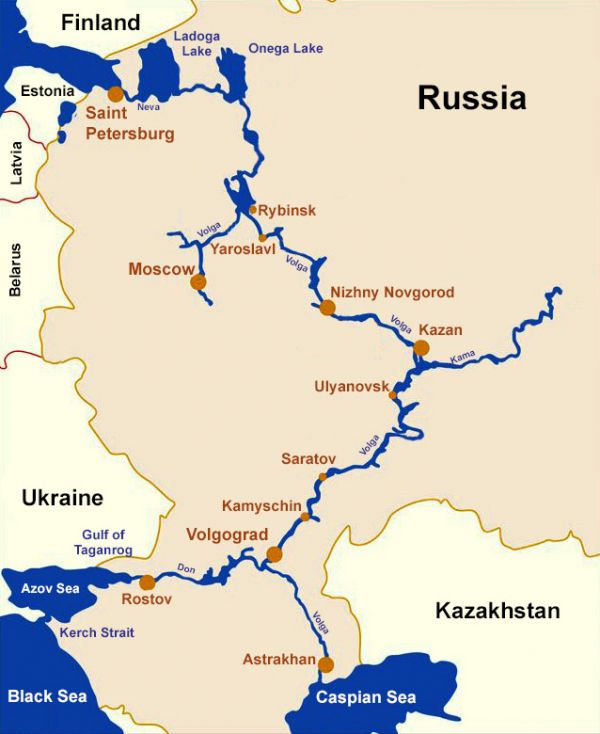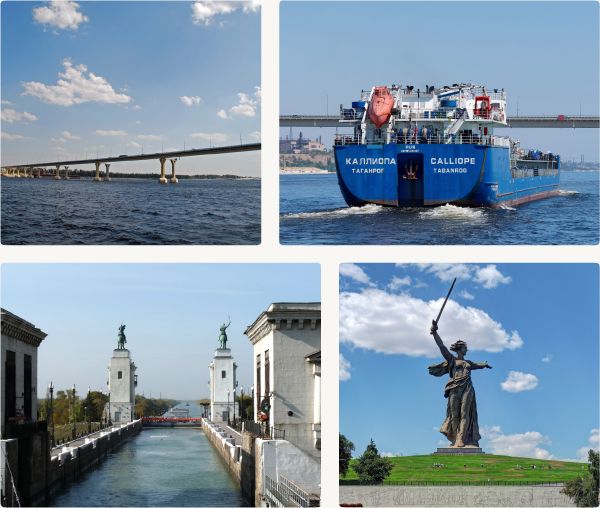News
-

- News
- Inland Ports
- Inland Ports - Volgograd, Russia
November 30, 2017
Inland Ports - Volgograd, Russia

First in this series about inland ports I presented to you the biggest inland port – Duisburg, on the river Rhine. Second came the ultimate river port of Manaus, on the River Amazon.
Now it is time to present the inland port with the most special location – Volgograd, on the river Volga. The location is fantastic. You can reach this port from the north or from the south on the river Volga. Join me on the trip! Both routes are great. Both are best started in the Atlantic.
For the first route, we travel through the English Channel and the North Sea into the Baltic Gulf of Finland, and onwards to St. Petersburg. From here we go into the river Neva, on the big lakes of Ladoga and Onega and then into the northern part of the Volga.
The Volga is a very long river. At 3,692 km, it is the longest in Europe. It is also Europe's largest river in terms of discharge and watershed. The source is in the north arctic region of Russia, not far from where we are now, on our journey south to Volgograd. The river flows through central Russia, down to Volgograd and the Caspian Sea.
At Astrakhan it has its delta, where the famous caviar can be bought. On our way down to Volgograd, we pass through famous Russian cities like Rybinsk, Yaroslavl, Nizhny Novgorod, Kazan, Ulyanovsk, Saratov and Kamyshin.
The Volga has a symbolic meaning in Russian culture and folklore and is often referred to as the mother river. I know that rivers are the source of human life and the river Volga floes steady and safe like the best mother you can imagine. A great river has great tributaries, like children. The Volga has the rivers Kama, Oka, Vetluga and Sura. The cold climate makes it freeze for most of it length for about 3 months per year – life is not easy for a river mother, either!

The second way to reach Volgograd is just as fantastic. Going through the Gibraltar Strait into the Mediterranean Sea towards the Greek islands, you go through the Marmara Sea and through the Bosporus Strait into the Black Sea. From here you enter the Sea of Azov through the narrow Kerch Strait towards Rostov, in the gulf of Taganrog.
Here you see many ships from Taganrog – a great place. From Rostov, we continue on the river Don towards the Volga, but just before the Volga the Don turns north. We reach the Volga and Volgograd through the Don-Volga canal. Volgograd is just to the port side when we come out. We have arrived again to Volgograd. What a port and what a location!

Volgograd is one of the largest cities in southern Russia. The city was first known as Tsaritsyn from 1589 to 1925, then as Stalingrad from 1925 to 1961 and finally as Volgograd since 1961. Today it is named after the Volga river that flows through the city.
The city has a very difficult history. Almost completely destroyed in World War 2, it has been rebuilt into a modern city. Today it is a major industrial, transport and cultural center. Industries in the city include shipbuilding, oil refining, chemical, and car manufacturing. The main cargo transported on the Volga is oil and grain. The city has 1 million residents, spread along 90 km of the banks of the Volga river.
Volgograd became famous for the battle of Stalingrad in WW2. This fierce battle in 1942 between the Germans and the Soviets saw the Germans bomb the city and gain about 90% of it before the Soviets fought back and took it back. Today some places are still in ruins in remembrance of these difficult times. At the time, a population of Germans were living along the Volga, engaged in industries like brewing and manufacturing of various goods. Where could they go? Not west, so they went east into Kazakhstan. Still today these minorities can be seen living there, keeping their language and traditions.
To commemorate the resistance, Volgograd was given the name of 'hero city'. A memorial was built on the highest point of the city at Mamayev Kurgan. In 1967, a statue was erected here called 'The Motherland Calls'. At 85 meters, it is the tallest statue in Europe and the largest statue of a woman in the world. What a great thing to have at the mother river of Volga!
I have seen many famous sights – the Eiffel Tower, the Golden Gate bridge, the Colosseum, the Pyramids, Christ the Redeemer in Rio, the four presidents at Mount Rushmore, the Sydney Opera House, and so on. But, the statue 'The Motherland Calls' in Volgograd is a best kept secret in this range of sites. It is a very special place to visit, going up the hill from the banks of the Volga.
The approach to Volgograd is second to none. It is a great place and a fantastic inland port.
Photo credits: CC BY-SA 2.0 - Alexxx Malev / CC BY-ND 2.0 - www.bbmexplorer / CC BY-SA 2.0 - Michael Clarke


